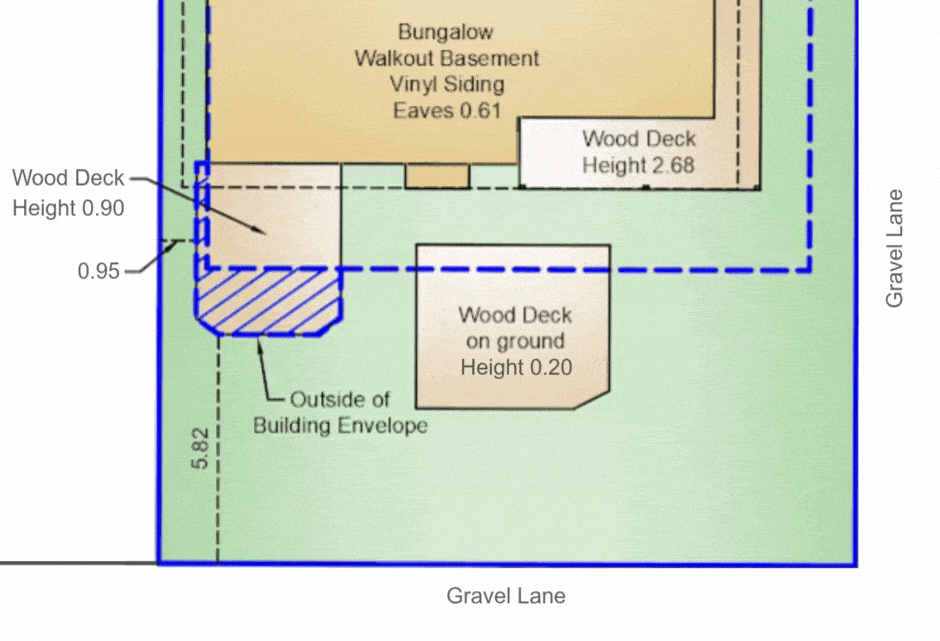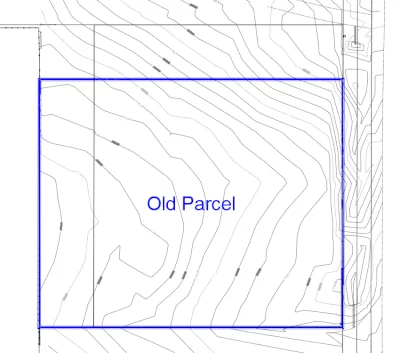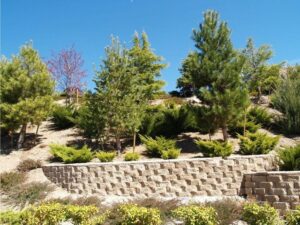Navigating City bylaws is one of the trickiest parts of home ownership and property improvement in Calgary. Sometimes, despite a homeowner’s best efforts, a project or existing structure doesn’t fit within the City’s land use rules. This is where a bylaw relaxation can offer real relief.
Below, we break down everything you need to know about bylaw relaxation and compliance in Calgary. We share step-by-step guidance, scenarios our clients have encountered, and expert insights drawn directly from principal surveyor Mark Sutter.
What Is a Bylaw Relaxation and Why Is It Needed?
Bylaw relaxation is the formal process of asking the City of Calgary to permit a property feature that doesn’t fully comply with existing land use bylaws to remain.
As Mark puts it, it is “a request to the City to gain permission to relax a bylaw that has been fractured by actions of a landowner.”
If a shed, deck, garage, or other feature doesn’t meet the City’s current setback or bylaw requirements, you’ll need to apply for a bylaw relaxation to bring your property into “acceptable” compliance and prevent issues down the line.
Common Scenarios That Require a Bylaw Relaxation
-
- Decks Too Close to the Property Line: In Calgary, any deck over 0.6m above grade must maintain a 7.5m rear yard setback and a 1.2m side yard setback. Anything closer triggers a relaxation request.
-
- Eaves and Cantilevers: Eaves encroaching into a setback, or cantilevers extending further than the bylaw allows.
-
- Pergolas or Additions: Structures added without proper plans and not meeting side or rear setbacks or attached to the main structure.
-
- Sheds Attached or Detached to Houses: Size of Sheds, or outbuildings positioned in the side yard, or attached to the main residence.
There are many bylaw limitations, and each zoning district can introduce new rules and exceptions.
How Non-Compliance Issues Are Identified
Non-compliance generally surfaces in two ways:
-
- During a Compliance Application: When owners, realtors, or lawyers apply for a compliance stamp (usually as part of a property sale), the City compares the real property report (RPR) to the land use bylaw.
-
- By City Reviewers: Planning technicians at the City review all submitted documents, including RPRs, photos of all features flagged for review, and supporting details. Any problems with height, size, distance, or permitted uses will result in a written notice with detailed requirements for resolution.
Steps to Apply for a Calgary Bylaw Relaxation
Applying for a bylaw relaxation in Calgary can feel overwhelming, especially if you’re navigating the process for the first time or dealing with an unexpected compliance issue.
Here’s how to move through the application process smoothly so you can protect your investment and keep your project or sale on track.
Preparing Your Application
Step 1: Start by making an application for compliance with the City of Calgary.
-
- In most cases, this is done through your land surveyor, but it can also be initiated by the homeowner.
-
- If the City finds a non-compliance during their review, your file will automatically be transitioned into a relaxation request without any additional cost.
Step 2: Respond promptly to the City’s requests for supporting documents:
-
- You’ll need to submit a current Real Property Report (RPR).
-
- Provide recent photographs that clearly show the property feature and its context on your lot.
-
- Prepare a written explanation for City reviewers, describing the issue and the feature in question.
-
- Include any additional supporting documentation requested by the City.
Step 3: Wait for City notification:
-
- The City will notify you when your application is considered complete and will inform you if anything is missing.
-
- The application then moves through review, approval, and public advertisement before you receive the final result.
-
- The entire process typically takes about two months from start to finish.
The Role of Real Property Reports in Compliance Applications
The RPR is the backbone of the relaxation and compliance process. Prepared by a professional land surveyor, your RPR portrays all critical structures, lot boundaries, easements, and key features.
City staff assess this plan against the Land Use Bylaw 1P2007 to determine if there are any infractions. Only when the RPR is up-to-date and accurate can an application proceed smoothly, making it a critical step for all property owners.
Understanding Calgary Land Use Regulations
Understanding Calgary’s land use regulations is essential for every homeowner and property buyer. Zoning sets the rules for what you can (and can’t) build or use your property for, impacting everything from additions and renovations to how close a structure can be to your lot line.
Zoning Rules and Their Impact on Property Development
Zoning designations in Calgary, such as R-C1, R-C2, R-4, commercial, or industrial, dictate the rules for what can be built, how high, how close to property lines, and with which uses or densities.
Every neighbourhood in the City is mapped and assigned zoning that affects lot size, permitted structures, and even limits on things like secondary suites.
The Land Use Bylaw 1P2007 sets out detailed definitions for each zone and corresponding rules about setbacks, lot coverage, and heights. Zoning changes can introduce both new flexibility and new constraints.
What Happens When a Property Violates Zoning or Land Use Requirements?
If a property is found in violation — for example, a commercial business in a residential area, or a structure built without the required setbacks — the City issues a notice for correction. Owners may need to apply for bylaw relaxation, modify or remove non-compliant features, or apply for a development permit for larger issues.
In rare cases, a property owner may have to cease a use outright if the zoning can’t support it.
Does a Bylaw Relaxation Affect Property Sales?
Selling a property in Calgary comes with its own set of rules, and non-compliance with city bylaws can quickly turn an otherwise smooth sale into a stressful experience for both sellers and buyers.
It’s important to understand how bylaw relaxations, compliance stamps, and outstanding issues can directly impact your ability to finalize a sale.
How Buyers and Sellers Are Impacted by Non-Compliance
The City of Calgary may withhold a compliance stamp if any non-compliant feature is discovered. This stamp is a common requirement in sale contracts. Without it, the sale can be delayed or even prevented.
When a property is non-compliant, everyone is impacted. A non-compliance can lead buyers to back out or ask for concessions. Delays in getting relaxation approval are stressful to all parties, especially as closing dates approach.
In Mark Sutter’s experience, “When compliance is resolved early, sellers are more calm and collected. They usually save money and avoid panic.”
Ensuring Your Property Is Ready for Sale with a Compliance Stamp
The best way to ensure a smooth sale is to be proactive. Order your RPR well in advance and apply for compliance before listing.
If a relaxation is needed, get the process started right away. Sellers who do this approach the market with more confidence and can negotiate from a position of strength.
Tools for Managing Your Calgary Property
The City of Calgary offers several online tools and resource pages which make it much easier to find answers to your property questions, research legal descriptions, and gather supporting documents if you ever need to apply for a bylaw relaxation or compliance stamp.
City of Calgary Resources for Property Owners
The City of Calgary’s website is packed with maps, guides, and permit information for property owners.
Use the Calgary MyProperty map tool to search community zoning, property details, permits, and even your councilor. There are also guides on compliance, bylaw relaxation, and how to resolve setbacks or easement encroachments.
Legal Description of Property in Calgary
Your legal property description can be found via Alberta’s SPIN2 land titles registry or the City’s MyProperty map portal.
This description, plus your civic address, forms the foundation of every compliance or relaxation application.
Residential and Commercial Land Use in Calgary
Before starting any new project or planning a renovation, every Calgary homeowner should know how their property is zoned and what that zoning allows.
The city’s land use categories (residential, commercial, or mixed) define what you can build, where you can build it, and how you can use your property.
What Is Residential Land Use and How Does It Work?
Residential land use (RC zoning) determines which types of residential buildings, additions, and structures you’re allowed to build within your Calgary neighbourhood.
Each land use code specifies the required yard space (setbacks), total lot coverage, and the kind of home you can construct (single-family, duplex, secondary suite, etc.). By regulating parking, building height, and even landscaping and accessory buildings, residential zoning protects the overall look and feel of each community.
Recent City changes have increased density in many areas, meaning that a growing number of houses can now add secondary suites, carriage houses, or even allow for multi-unit residential buildings, depending on the zoning.
Always check your zoning before pursuing any new build or substantial renovation; complying with residential land use codes will save you time, money, and stress.
Property Zoned for Both Commercial and Residential Purposes
Combined-use zones, often along busy roads or near major intersections, allow both residential and commercial structures (like apartments over storefronts).
These districts require careful review of both the land use bylaw and the development permit process to plan, build, or sell property.
Frequently Asked Questions About Calgary Bylaw Relaxation
How Long Does the Bylaw Relaxation Process Take?
Plan for about two months from application to final approval.
The process includes submitting your compliance application, supplying photos and an RPR, review and assessment by the City, and finally, public advertising and approval.
What Happens If a Bylaw Relaxation Application Is Denied?
If your relaxation is denied, you’ll need to either apply for a larger development permit or remove or alter the offending feature.
On rare occasions, a significant redesign or even a cessation of property use may be required for compliance.
Choose Third Rock Geomatics for Your Bylaw Relaxation Needs
At Third Rock Geomatics, we are real property report and compliance application experts.
We understand the stress that non-compliance can create. We’ve helped hundreds of Calgary homeowners, realtors, and developers resolve issues quickly and efficiently — with the right documentation, clear guidance, and full communication from start to finish.
Whether you need a new RPR, an up-to-date property survey, or support preparing your compliance application, we simplify the process so you can focus on what matters most.
Take the stress out of bylaw relaxation and compliance in Calgary. Contact Third Rock Geomatics today!
This informational blog is meant to support Calgary homeowners and real estate professionals. For specific legal advice or to verify the requirements for your unique property situation, consult with a professional surveyor or the City of Calgary’s planning department.





